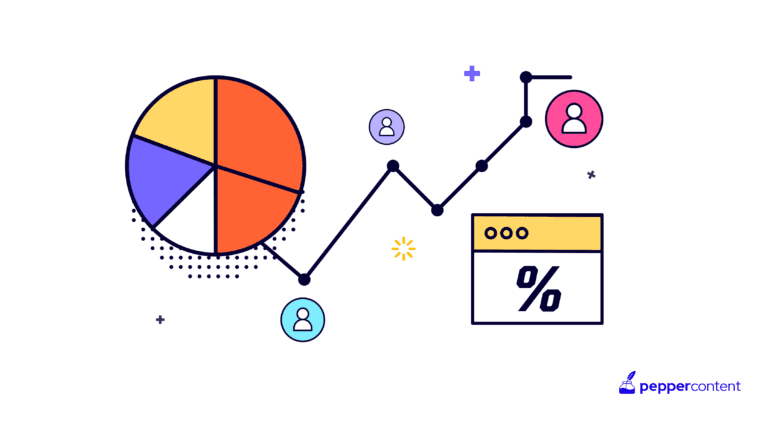The Role of a Pillar Content Strategy In Marketing

Table of Contents
- What is a Pillar Cluster Strategy?
- Defining The Length Of A Pillar Page
- Creating A Pillar Page
- What Are SEO Topic Clusters?
- Pillar Pages, SEO, and Business
- Key Takeaways
- Conclusion
- FAQs
Our behaviors and habits have evolved and adapted to the digital age and continue to do so. This is also probably why Internet algorithms that offer up search results also continue to evolve. Search engine algorithms were always notorious for the frequency at which they change, but they have changed beyond comprehension this time around.
Optimizing one’s blogs and websites with keywords alone will not serve the desired results anymore. Today, the pillar content strategy holds the key to ranking content higher on search engine results pages (SERP). Gone are the days when brands could hope for healthy organic traffic to their websites just by providing a catchy heading or offering quality content with keywords strategically scattered across. These are still important, mind you, if you still expect to generate organic traffic, these are still important, mind you. However, they alone will not be enough for the search engine to pick your content from the many available online.
One of the reasons for this is that today’s search engine is designed to prioritize the website’s authority on the topic while selecting digital content for every search query. Traditional marketing trends of long-tailed keywords, catchy titles, and outstanding content alone is not enough to demonstrate that authority anymore. However, a strategy that has been helping search engine specialists in this context is the pillar structure content strategy and topic cluster content strategy.
While pillar content strategy has been in practice for some time now, it has once again picked up steam, thanks to the change in the search engine algorithms. Read on if you would like to know more about pillar content, topic clusters, how they help in SEO ranking strategy, and more.
What is a Pillar Cluster Strategy?
The simplest way to envision a pillar cluster content strategy would be to think of a book with a table of contents for all the chapters in the book followed by the detailed chapters themselves. Well, in the digital world, with its many search engine algorithms, a pillar cluster content strategy is like the index and the chapters of the book, but just a little bit more detailed and complex.
A pillar content for SEO is a high-level overview of the content that primarily helps answer any queries related to a given topic a user may be searching for in a search engine—this broad-level content further links into relevant and detailed subtopics.
Pillar content SEO is not only the backbone for generating organic traffic for websites and digital content alike; it is specifically designed to provide value to the users searching for any specific topic.

Defining The Length Of A Pillar Page
There is no hard and fast rule as to how long the pillar content should be. But, they usually are longer than regular blog content. What is worth noting here is that they also need to be comprehensive despite being long.
Even though these pages are critical for content to get noticed by search engine algorithms, they work best when they work in tandem with the topic cluster strategy. Remember, pillar pages always draw their strength from the SEO topic clusters they are linked to. Most pillar posts comprise at least 2000 words or above as a general guideline.
Being longer than a regular blog post, pillar pages usually offer in-depth information to the users and add value to the users’ search. However, they also leave room for the topic cluster strategy to kick in and offer a detailed explanation.
Creating a Pillar Page
Here’s a quick four-point strategy on how to build a pillar page.
- Decide the theme you want to write about and rank for. The topic has to be broad enough to include multiple content clusters in the form of blogs, articles, etc.
- Research extensively and list all the keywords. The best way to do this is to think about each of the customer personas who might be interested in this content and the questions they may ask at each stage of the customer journey.
- Group the keywords into topic clusters. This is the most crucial step before creating the content. This step would determine the success or failure of this content strategy. If necessary, use keyword grouping tools, but group the keywords for each blog post, then club these blogposts into relevant clusters. Only once you have organized the keywords, start writing the cluster content.
- Get set and go with the pillar content. Take care to start writing the pillar content only once you have the entire cluster content ready, as it is easier to summarize instead of working the other way around. Remember to keep the headlines short, so they can be covered in detail by the cluster content. At the same time, provide just enough to keep the user engaged. Finally, remember to optimize the entire content, for the entire exercise would be of no use otherwise.
What Are SEO Topic Clusters?

Working in the hub and spoke model, topic clusters are made of tightly organized content that is related to a core topic, which forms the pillar page. Under the topic cluster content strategy, each pillar page is surrounded by multiple cluster pages explicitly created to strengthen the central pillar page.
SEO topic clusters comprise three key elements:
- The central pillar page: This page touches upon the main theme of the entire topic cluster and is also the component that helps answer the queries raised by users in the search engines.
- Multiple cluster pages include detailed content that helps strengthen the central pillar page. While the main pillar page gives an overview of any topic, the cluster pages allow you to dive deep into the central topic. Further, the content of each cluster page is usually designed to go into details of a specific element that a user searched for in the pillar page.
- Internal links: These are usually more strategic and are placed carefully to ensure communication between the pillars and the clusters and to offer users a seamless experience.
While the pillar pages cover specific topics that the users search for, the cluster pages usually cover particular keyword phrases that the users search for within those topics. Also, cluster pages are linked back to a specific pillar page, and the pillar page is also connected to each of the related topic clusters. If the case demands, the cluster pages may also be linked to other cluster pages. In some instances, topic clusters may be further linked to other supporting sub-clusters or secondary clusters.
Pillar Pages, SEO and Business
We have now established what pillar content and topic clusters are. We have also established that pillar content strategies are critical to enjoying a better search ranking with the change in the search engine algorithm. But, how do the pillar pages really help SEO build a brand or business? What are the other benefits brands enjoy with this model?
It ascertains your content’s authority
One of the key ranking parameters of Google and other search algorithms is to ascertain your authority on the topic before they decide upon your content’s ranking. By following the hub and spoke model of topic cluster strategy, you give your content a clean structure and help the search engine understand and parse through your content. While the pillar clearly answers the user’s query, the links to the topic clusters also help strengthen your authority on the topic for the search engine algorithm. With both the pillar and cluster talking about the same topic, Google and other search engines understand immediately what these content pieces are all about. This helps the search algorithms rank one content above another.
It helps increase engagement
When you organize your content using the pillar and cluster model, you automatically organize your content. An organized content ultimately leads to clarity of thought and helps the users absorb more. This ultimately leads to an increase in the users’ engagement time. The longer a user spends with the content, the content’s authority on the topic, too, automatically increases.
It helps with a longer session duration
With the pillar and cluster pages being interlinked, the user can drill down as deep into the content as they want. In fact, in some cases, not only do the pillars have clusters linked to them, but the users are also able to dig deeper into the secondary clusters without losing interest in the content or without a monotony setting in. This helps the users stay longer with the content page, helping drive up both the engagement and the page views.
Key Takeaways
- A pillar-cluster model works like the hub and spoke model, wherein, while the pillar helps answer the users’ search query, the cluster targets the search keywords and helps the users dig deeper into the topic.
- A pillar helps provide an overview of the core topic while leaving room for the clusters to provide more insight into the topic.
- This content model works well for SEO by helping showcase your authority on the topic searched for by the user.
- This model not only helps improve the page rank for digital content but, with its internal links and detailed cluster pages, it also helps build authority on the topic with search algorithms.
- This kind of content is usually exhaustive, helping the users cover the topic in as much detail as possible.
- While the possibilities to add internal links between the pillar page, SEO topic clusters, and the secondary clusters, are plenty, the links need to be strategically placed such that they appear just at the right moment.
Conclusion
Although considered one of the most effective digital marketing strategies, the pillar cluster strategy comes with its own set of challenges. Not only is it a lot of work to search for topics and to build the elaborate pillar and cluster content, but it can also hamper the content’s SEO ranking if not stitched together well. Even if you manage to get this right, it is challenging to promote the content to the right audience, requiring both time and resources.
However, when executed well, the pillar content strategy can work wonders for a brand, not just in helping the page rank its content with the search engine algorithm but also in helping improve the engagement with the users.

FAQs
A good pillar page can also be described as a complete guide. It should be able to answer specific queries with quality content.
A list of 3-5 topics that the brand will consistently discuss and amplify is a content pillar. These are also the topics for creating social media content, known as content categories or content buckets.
Once you promote the pillar page, it is recommended to promote a few content pieces each week. The promotion should be staggered to keep the engagement and buzz active and growing.
The social content pillar is a set of keynotes used to create social posts. These concepts are specific to the brand and should be engaging and popular with the online audience.
Editorial pillars are sets of topic clusters that reflect the brand image and engage the consumers’ minds.
This model simplifies blogs by focusing on one central topic rather than one master guide with several keywords. Topic clusters SEO is an intent-based approach for simplifying the content approach.
Pillar content provides a complete answer to a specific topic with comprehensive and accurate information. It is specifically designed to provide a combination of trusted, useful, engaging, and valuable information to a reader.
Latest Blogs
In this blog, explore the golden rules of using AI marketing tools so you can leverage the benefits to their maximum potential.
In this blog, you’ll learn how to avoid the pitfalls of SEO over-optimization while enhancing your site’s performance.
In this article, we’ll take a look at what AMP is, its advantages and disadvantages, and how it affects SEO.
Get your hands on the latest news!
Similar Posts

Content Marketing
8 mins read
The Ultimate Round-Up of Content Marketing Tips from 2023

Content Marketing
6 mins read
Content Marketing in the Age of Big Data: Leveraging Data for Competitive Advantage

Content Marketing
6 mins read